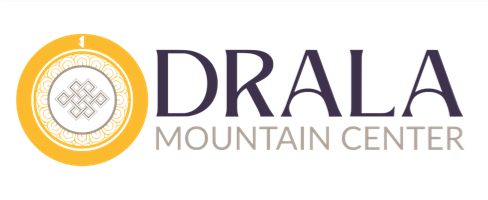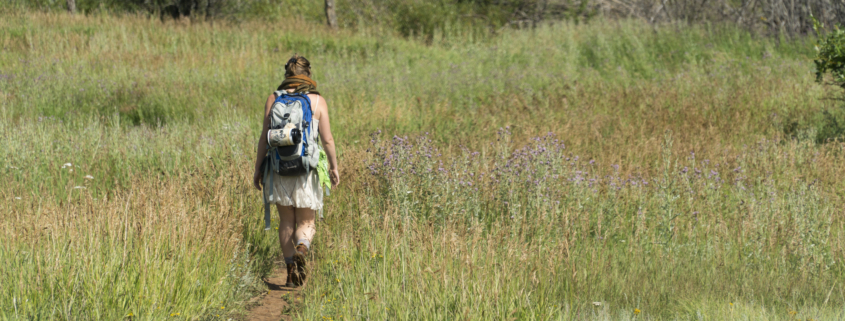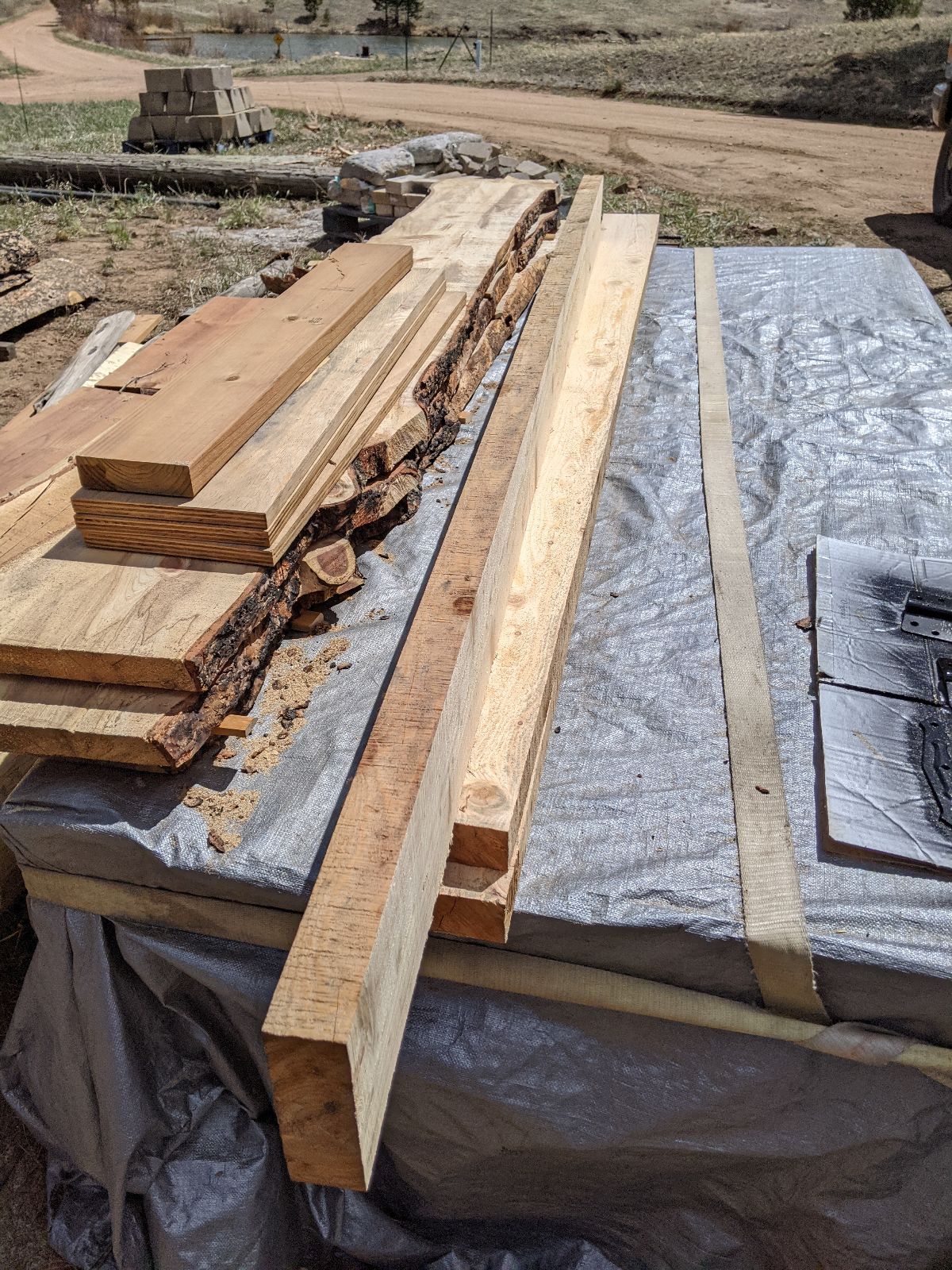Sustainability and Land Stewardship at Drala Mountain Center
Sustainability and Land Stewardship at Drala Mountain Center
Long before I came to work at Drala Mountain Center my life was profoundly impacted by this place.
Plenty of people can say that, of course. Drala Mountain Center offers a huge variety of transformative teachings, retreat experiences, and independent retreat opportunities that can change your life. But that isn’t what I’m personally talking about.
The Cameron Peak Fire – and How Drala Mountain Center Turned the Tide
In late 2020 the Cameron Peak Fire started a few miles from my home. Much like any wildfire in this area, you can’t live in the Colorado mountains without occasionally experiencing wildfire, locals assumed it would be an issue for at most a few weeks. Life went on as normal. Except, this fire was anything but normal.
The rocky terrain so familiar to us at Drala Mountain Center is incredibly challenging territory when it comes to fighting fires. The dense ponderosa pine forests are ripe with unburnt fuels, and pine beetle infestations leave those forests even more vulnerable than usual. Jagged peaks and narrow valleys make navigating the land a challenge, and can even make it impossible to drop water from planes and helicopters in the fight against destructive fires.
All of these factors and more meant that the Cameron Peak Fire didn’t just fizzle out in a few days or weeks. Instead, for a full month, Cameron Peak grew and blazed in untouchable terrain, far from where firefighters could access or meaningfully combat the flame.
Finally, on the morning of Labor Day 2020 we got the call. We were officially in a mandatory evac zone and needed to get out.
Drala Mountain Center had actually already evacuated long before my household in Glacier View Meadows needed to – but that didn’t mean their contributions to the efforts against the fire were over.
Within days of evacuating, the Cameron Peak Fire made a historic run, consuming thousands of acres of land. For many in my community, which lives within a few miles of Drala Mountain Center, the greatest fear was that our homes had already burnt, we just didn’t know it yet.
As firefighters did everything they could to protect people, structures, and livestock in the area there wasn’t time to give status updates. The growing column of smoke, visible throughout much of the Front Range, painted a dire picture.
Our homes didn’t burn.
There’s one main reason they didn’t burn. Drala Mountain Center.
You see, in the years preceding the Cameron Peak Fire Drala Mountain Center had invested in active forest management projects. They had intentionally thinned much of the ponderosa forest on their property, back down to the level the land and available water could support. They’d removed fuel from the forest at the same time, reducing the most combustible materials in the area to a more manageable level.
All of that work is what natural forest fires accomplished long in the history of this region. But decades of active fire suppression lead to overgrown forests and an unusual abundance of fuels normally reduced in regular small fires. By removing the excess, Drala Mountain Center worked to return the forest to a much more sustainable and natural state.
Those same efforts were exactly what saved my home, and hundreds of other homes in this area. While the Cameron Peak Fire made its first historic run (there would be several more periods of extreme fire behavior over the following months) firefighters had found a location they had a fighting chance of stopping the spread.
Why was Drala Mountain Center that fortress against uncontrolled fire?
Because the moment the Cameron Peak Burn hit those managed lands on the property, it cooled. The lack of fuel meant that the extreme fire behaviors the fire was exhibiting in other regions weren’t possible in the managed land. Lake Shinyuta, a small pond created on Drala Mountain Center’s property, provided a quick and meaningful supply of water which the helicopters and fire engines could use to reduce fire behavior. Well-maintained access roads meant that fire engines and other support vehicles could be brought directly to Drala Mountain Center, and even approach the front lines of the fire.
In the first days after my household evacuated, Drala Mountain Center had already done the work needed to save our homes, quietly, without fanfare, saving hundreds, maybe thousands of structures and whole communities that wouldn’t have survived with them.
That was just the beginning.
If you’d like to learn more about the story of Drala Mountain Center – then Shambhala Mountain Center (SMC), the Cameron Peak Fire, and the other forest management projects in our surrounding area that changed the game during the Cameron Peak Fire – watch Fireforest. Fireforest is a 16 minute documentary by Evan Barrientos with support from Mighty Arrow Family Foundation, Coalition for the Poudre River Watershed, City of Fort Collins Utilities, Northern Colorado Fireshed Collaborative, Peaks to People, and American Wildfire Experience.
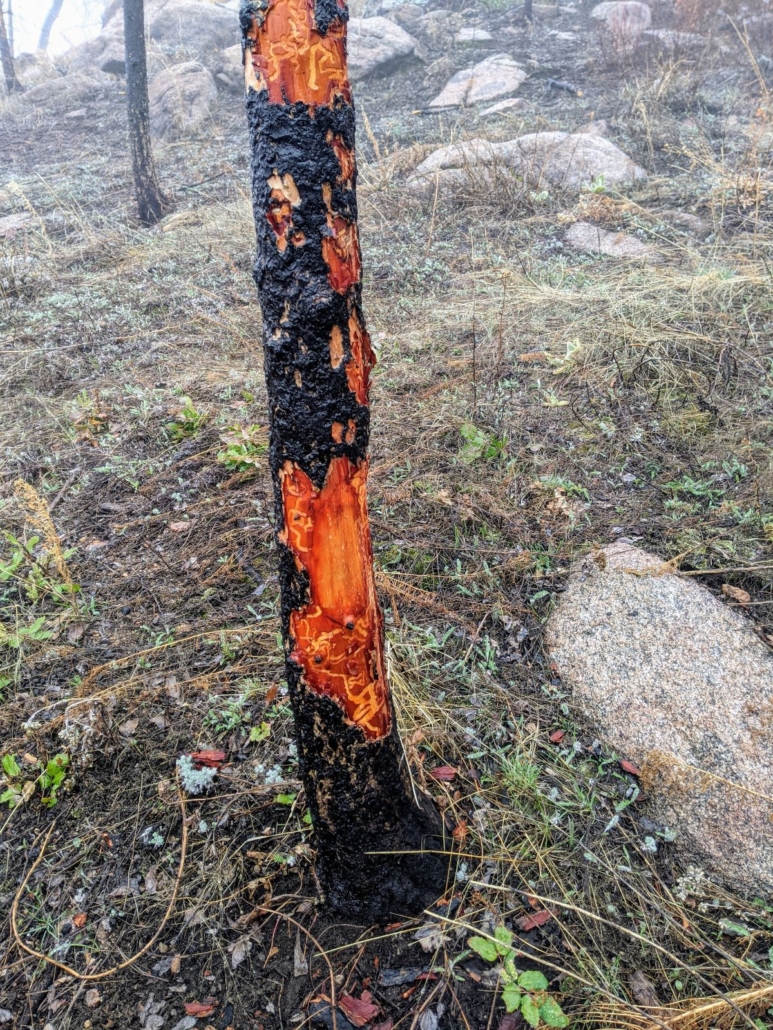
Photo by Wes Farrell – a young ponderosa pine tree standing in the Cameron Peak Burn Scar at DMC.
Sustainability and Stewardship
At Drala Mountain Center, land stewardship and sustainability aren’t optional or bonuses. Taking care of our sacred land is at the core of what we do. We have a responsibility for stewardship to preserve not just the wisdom teachings and contemplative practices of the world for future generations, but to preserve them in this place. Surrounded by our sacred land. We are protected and encouraged by its fierceness, tenacity, and wildness.
In the years since Cameron Peak, everything has changed. But our commitment to this land is the same as ever.
One of the things that means is thinking about how we’re going to recover from the fire. Because 5 years out, we’re still recovering.
There’s a lot to think about, like when to take down the burnt trees that are starting to fall, and how to preserve some of them as an important habitat for birds, animals, and insects returning to the land.
The stream running through the land is another great example, it was damaged in the fire, but we have the power to help restore it.
Here are some of the things we’re doing now to improve sustainability and take care of the land.
New Sawmill and the Opportunity to Build Our Own Furniture
Photo by Wes Farrell, Lumber ready for use from our new sawmill.
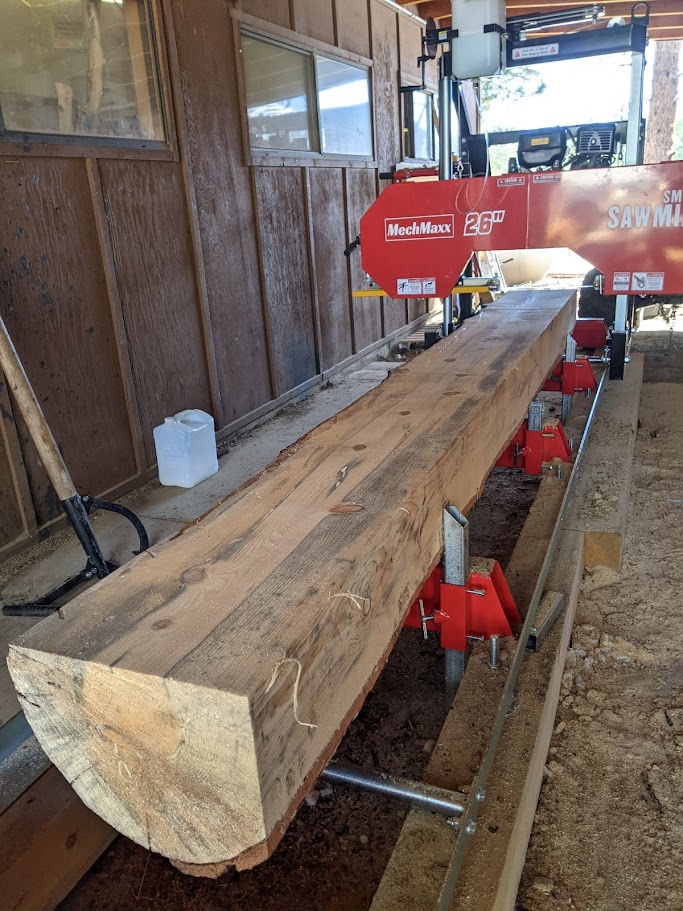
Photo by Wes Farrell – our new Drala Mountain Center sawmill in action.
One of the biggest changes that has already happened in 2025 was that Drala Mountain Center was able to invest in our own small sawmill.
Why get a sawmill?
Simple – to make use of all the lumber resources available on the land to build a better campus, more meditation supplies, and enhance our outdoor spaces.
Right now we’re able to make great use of the burnt trees from the fire, many of which are starting to fall and need to come down, but that still have high-quality wood before they start to rot.
While we are letting some of the trees rot naturally, returning their energy and nutrients to the soil, others are perfect for producing new lumber. Since we also have several woodworkers and carpenters on the team, that means that we can start producing some of our own furniture.
Projects include new tent furniture, shelving for various spaces around campus, benches and chairs for outdoor seating, and much more.
Revitalizing Trails
One of the best parts about being at Drala Mountain Center is the opportunity to spend some time out in nature, enjoying fresh mountain air, and seeing the abundance of sub-alpine plants and animals that call this place home.
To do that we need a strong trail system. Good trails preserve the surrounding environment while still offering access to visitors, hikers, and people who just want to see the sites.
Our facilities crew is using some of our existing tools and equipment to widen previously established trails and make them more accessible. At the same time we’re looking for opportunities for more trails and how we can make our existing trails more suitable for the full range of human mobility.
As we continue landscape cleanup we’re also chipping some of the fallen trees that are no longer suitable for lumber or firewood. Those chips then provide mulch for maintained garden areas, and can be used as a trail surface as well.
Water Use Management
One of the most important parts of land stewardship in the Colorado mountains is awareness of water resources and how they are used.
Previous projects like our wastewater treatment facilities, wells, and Lake Shinyuta all contribute to the responsible use of our natural water and the local water table. We’re committed to continue that responsible use of water.
In the last year our Facilities team has been hard at work improving our water systems, getting new boilers for Rigden Lodge, and repairing damaged plumbing. Each of these initiatives has helped to reduce our water and electrical use at Drala Mountain Center.
That means less impact on the land, and more resources for building back and continuing our other land restoration efforts.
Stream Restoration
Large wildfires aren’t just destructive for the plants and animals and structures in the path of the fire. They can also cause massive changes to landscapes, water ways, and ecosystems.
One of the biggest ongoing challenges after the fire is that Drala Mountain Center’s stream was significantly damaged in the fire, and human-supported restoration work is critical to ensure it’s long term health and current path and placement.
We’ve already begun working on this restoration, pulling out garbage caught in the stream and surrounding plants, pulling remnants from the fire out, clearing sticks and twigs clogging the flow, and otherwise working to make the stream and cleaner healthier waterway.
We’ll also be working with Larimer county over the next couple of years to continue restoration.
Animals Returning to Drala Mountain Center
Up until last year, 2024, elk were very rare at Drala Mountain Center, and may not have come to campus at all some years.
Last year a large herd of elk visited Drala Mountain Center several times through the spring and then again in the fall. While we don’t know if that was a one-time event or a restoration of local elk migratory patterns yet, we’re hopeful that elk and other animals will continue returning.
We’ve also noticed a local beaver population returning, though not yet on Drala Mountain Center land.
Hopefully, between our existing ecological restoration work, and our efforts to restore the stream, we’ll be able to say there are beavers at Drala Mountain Center very soon.
Our facilities crew is also happily taking care of a few ducks, who call lake Shinyuta their home. Their success is a good sign for animal and bird populations at Drala Mountain Center.
Future Goals
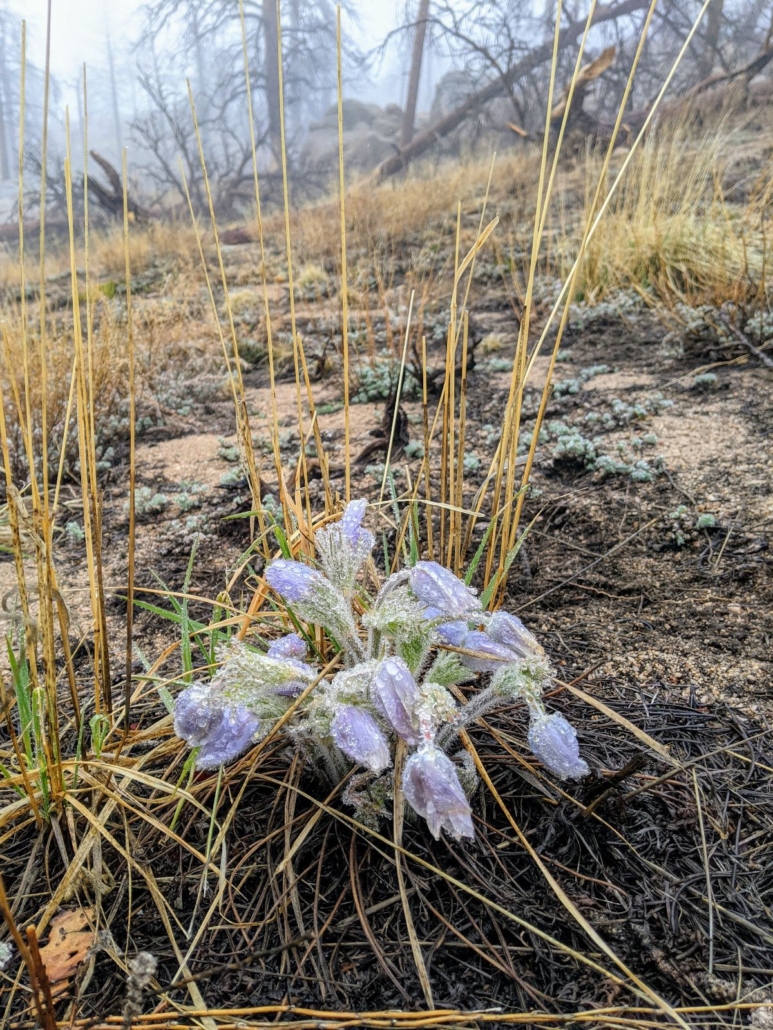
Photo by Wes Farrell – Crocus flowers emerging in the burn scar – the land coming back to life.
We’re already incredibly invested in maintaining the land and increasing sustainability at Drala Mountain Center, but that doesn’t mean that we’re not adding to our list of projects and goals.
Longer term, Drala Mountain Center is looking to add more sustainability projects that we aren’t ready for quite yet. These include continuing the forest management work that saved so many homes during the Cameron Peak Fire, bringing honey bees to Drala Mountain Center to pollinate native wildflowers and provide a supply of honey.
Our head chef is also deeply committed to growing more of our own food at Drala Mountain Center. To this end, we’re looking at projects like building an additional greenhouse, or even several greenhouses, recreating our outdoor gardens, and permaculture.
We’re also looking into bear-safe means of composting, and producing health-code compliant compost to fertilize those greenhouses and gardens.
There are ideas around restoring our native plants botanical garden, and creating a larger botanical garden as well.
As we continue our forest management and fire recovery efforts, we’re also very aware that many of the local homes are reliant on firewood for winter heat. We’re exploring ways to make our lumber resources available to the community both to keep those supplies local and sustainable, and as a source of funding for our continued restoration efforts and operational costs.
A New Discovery – Drala Mountain Center Crystals
With so much work happening in many different parts of our 600-acre campus, it was almost inevitable that we would get at least one surprise while working. Well, we’ve gotten that surprise!
Our facilities crew has found a couple of different crystal deposits on land in different areas. While we haven’t tested the crystals to know for sure, they predominantly appear to be Red Feather quartz, and many of the crystal points display a unique red streak near the point which is unique to this area.
The Red Feather Lakes region is also known for Amethyst and Garnet deposits, so who knows… maybe we’ll find even more crystals in the future!
